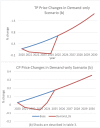An analysis of African Swine Fever consequences on rural economies and smallholder swine producers in Haiti
- PMID: 36311651
- PMCID: PMC9597192
- DOI: 10.3389/fvets.2022.960344
An analysis of African Swine Fever consequences on rural economies and smallholder swine producers in Haiti
Abstract
African Swine Fever (ASF) causes high mortality and often results in strict culling policies for affected pigs and international market restrictions. It took more than 25 years for swine inventories in Haiti and the Dominican Republic to recover from an ASF outbreak that took place from 1978 to 1984. The 2021 outbreaks in the Dominican Republic and Haiti pose threats to animal health, livestock markets, and producer livelihoods. A partial equilibrium Haitian pig sector model (HPM-2021) was developed to assess the economic impacts of a 2021 Haitian ASF outbreak of a similar size to the 1980s outbreak. The dynamic model examines ASF impacts from 2021 to 2024, through 100 iterations of stochastic supply shocks, and three specific demand shocks. Recovery alternatives are assessed through 2030, and outbreaks and recovery outcomes are compared to a baseline reflecting 2019 trends. The analysis includes economic effects on national pork and maize in Haiti, the Dominican Republic, the rest of the Caribbean, and the rest of the world. Findings demonstrate higher vulnerabilities of the traditional sector to ASF-related disruptions. The inflated prices generated by pork production shortfalls are an opportunity to accelerate income growth for remaining traditional pig producers. When there is no consumer avoidance, the production losses caused by ASF generate high prices and contribute to a minimum of 49% increase in traditional sector revenue, and a minimum of 2.22% revenue growth in the commercial sector from the 2019 base year. Nevertheless, the potential for consumer avoidance of pork cause prices to decrease and offset those gains by as much as 90% in the traditional sector and 44% in the commercial sector. Smaller commercial sector impacts derive from different elasticities. ASF-induced high prices also lead to increased consumer expenditure losses by up to 200% over the outbreak period. Nevertheless, consumer expenditures tend to recover instantaneously with ASF eradication. Due to persisting demand shocks, producers will earn up to 0.3% lower than baseline levels income from 2027 to 2030. Few models evaluate the economic impacts of health response policies in less developed countries like Haiti. HPM-2021 results highlight ASF impacts on prices, which can benefit certain producers and disincentivize on-farm disease reporting. Slow recovery and consumer avoidance of pork are detrimental to long-term swine industry survival, producer livelihoods, and the overall rural economy.
Keywords: African Swine Fever; Haiti; animal health; economic impact analysis; partial equilibrium model.
Copyright © 2022 Jean-Pierre, Hagerman and Rich.
Conflict of interest statement
The authors declare that the research was conducted in the absence of any commercial or financial relationships that could be construed as a potential conflict of interest.
Figures






References
-
- USDA Statement on Confirmation of African Swine Fever in Haiti (2021). United States Department of Agriculture, Service AaPHI.A. Available online at: https://www.aphis.usda.gov/aphis/newsroom/stakeholder-info/sa_by_date/sa... (accessed May 26, 2022).
-
- USDA Statement on Confirmation of African Swine Fever in the Dominican Republic United States Department of Agriculture Service, AaPHI. (2021). Available online at: https://www.aphis.usda.gov/aphis/newsroom/news/sa_by_date/sa-2021/asf-co... (accessed May 26, 2022).
-
- ASF Dominican Republic: “We are up against an invisible enemy”. Pig Progress. (2022). Available online at: https://www.pigprogress.net/health-nutrition/health/interview-we-are-up-... (accessed May 26, 2022).
-
- African Swine Fever Confirmed in Haiti. Ohio's Country Journal. (2021). Available online at: https://ocj.com/2021/09/african-swine-fever-confirmed-in-haiti/ (accessed December 21, 2021).
-
- Haiti Interim Swine Repopulation. United States Agency for International Development. (1983). Available online at: http://faculty.webster.edu/corbetre/haiti/misctopic/pigs/gaertner.htm (accessed September 15, 2021).
LinkOut - more resources
Full Text Sources

